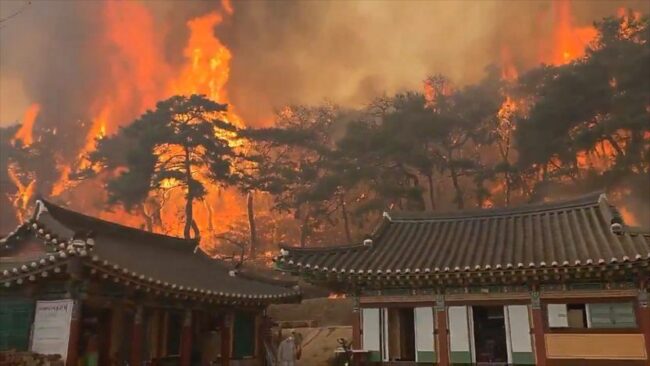At least 24 people have been killed as devastating wildfires continue to sweep through South Korea’s south-east region, forcing more than 23,000 people to evacuate their homes.
Authorities report that most of the victims are in their 60s and 70s, while at least 26 others are injured, including 12 in critical condition.
The ongoing fires have been described as “unprecedented” and are “rewriting the record books for the worst wildfires in our nation’s history,” acting president Han Duck-soo said.
According to the BBC, the flames have also gutted the historic Gounsa temple in Uiseong city, a 1,300-year-old Buddhist site, prompting authorities to relocate cultural relics to safer locations.
The fires began in Sancheong county on Friday afternoon before spreading to Uiseong and advancing toward neighbouring counties, including Andong, Cheongsong, Yeongyang, and Yeongdeok.
Strong, dry winds have fuelled the rapid spread of the blazes, with Lee Byung-doo, a forest disaster expert at the National Institute of Forest Science, describing the Uiseong blaze as advancing at an “unimaginable” scale and speed.
Efforts to contain the fires have been extensive, with thousands of firefighters and around 5,000 military personnel deployed. Helicopters from the US military stationed in Korea have also been brought in to assist. However, firefighting efforts faced further challenges on Wednesday when a helicopter crashed in the mountains of Uiseong county. Authorities are investigating the cause.
In response to the crisis, the national fire agency raised the alert to the highest fire response level on Tuesday, marking the first time such an alert has been issued this year.
Wildfires are relatively rare in South Korea, and fatalities have historically been uncommon, making the current disaster the deadliest in the country’s history. So far, 18 people have died within the past few days alone.
The fires have already consumed approximately 17,000 hectares (42,000 acres) of forest, making this one of South Korea’s largest wildfire disasters in terms of area burned. Among the cultural losses, authorities confirmed the destruction of a Buddhist architectural structure from the Joseon Dynasty (1392-1910), which had been designated a national treasure.
A 68-year-old monk expressed his devastation over the destruction of the Gounsa temple, saying, “We will do our best to restore the function of the temple.” He added, “It was an extremely painful feeling, and I wondered why something like this could happen.”
Witnesses described harrowing scenes as flames engulfed mountains and residential areas. Truck driver Lee Seung-joo, 39, recounted watching the mountains burn like “literal hell” as he drove past. “It was like the apocalypse,” he said.
In Andong, evacuees sheltering at an elementary school were forced to flee as strong winds carried flames closer. “The wind was so strong,” said 79-year-old Kwon So-han. “The fire came from the mountain and fell on my house.”
ALSO READ: South Korea: Man swallowed by Seoul sinkhole found dead
Acting president Han stressed that all available personnel and equipment had been deployed, but strong winds continued to hinder efforts to bring the fires under control.
“We were desperately hoping for rain today or tomorrow to help extinguish the flames,” he said, acknowledging that the level of destruction was “unlike anything we’ve experienced before.” However, forecasts indicate little relief, with only five to 10mm of rain expected on Thursday.
The government has pledged to review shortcomings in wildfire response and enhance prevention measures once the crisis is under control. Han emphasised the challenges of fighting wildfires, noting, “Once a wildfire starts, extinguishing it requires tremendous resources and puts precious lives in danger.”
South Korea has been experiencing drier-than-normal conditions, with significantly less rainfall than average.
Authorities report that 244 wildfires have already been recorded this year, 2.4 times higher than the same period last year. In response, the government has vowed to strengthen enforcement against illegal burning, one of the leading causes of wildfires, and crack down on individual negligence.
ALSO READ TOP STORIES FROM NIGERIAN TRIBUNE




